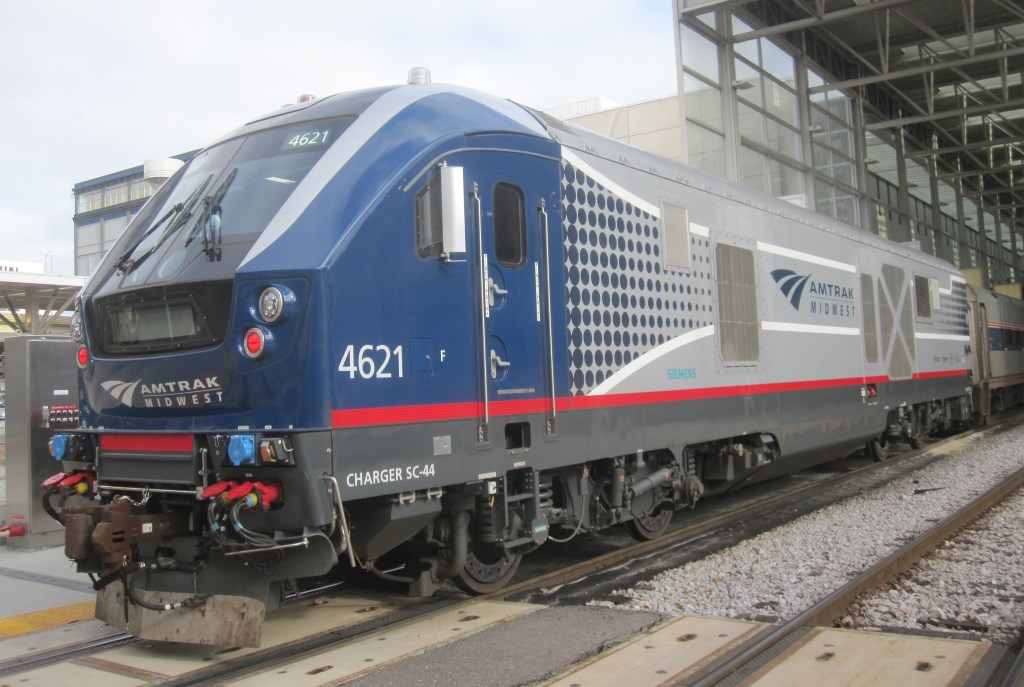State Will See Improved Passenger Rail
Doubling daily service from St. Paul to Milwaukee and Chicago and higher speed rail to Duluth-Superior.
A variety of railroad projects are coming together to greatly improve passenger service in Wisconsin, including “higher speed” rail.
They include: doubling daily service between St. Paul and Chicago; increasing the number of round-trip Milwaukee to Chicago trains from seven to 10; express service between Minneapolis and Duluth-Superior; and, already underway, more than $5 million in improvements to the Milwaukee Airport Railroad Station at General Mitchell International Airport, with completion expected in 2023.
Funding for several of the projects is included in Minnesota Gov. Tim Walz’ Building One Minnesota plan, announced Jan. 15. Walz proposes $2.6 billion in bonding to invest in education, environment, public safety and infrastructure.
He sets aside $10 million for his state’s share of design and environmental work “for a second daily Amtrak train between the Twin Cities, Milwaukee, and Chicago [TCMC].” Walz proposes another $5 million for Minnesota’s Rail Service Improvement program, to increase rail shipping, improve rail facilities and encourage related economic development.
Of all the projects, TCMC may have the greatest economic impact to Wisconsin. Amtrak’s round-trip Empire Builder service crosses from Minnesota to Wisconsin at La Crosse, continuing southeast to Tomah, Wisconsin Dells, Columbus, Milwaukee and, finally Chicago. Top standard speed is 79 mph.
“In the past few months, we have heard from all of the station communities, counties, and members of the business community of their desire and support for the TCMC second daily round-trip, stating that it would improve their travel options and the ability to use the service as a tool to attract and retain businesses, jobs, employees, and residents to their communities,” says Arun Rao, passenger rail manager for the Wisconsin Department of Transportation [DOT].
For example, officials in Winona, Minn., a city of 28,000, 28 miles north of La Crosse, anticipate as many as 16,000 additional visitors a year.
“The project is operationally feasible and would improve the utility of an existing intercity passenger rail corridor for [Wisconsin],” says Rao. The soonest a second train could be added is 2023. “We’re already working on environmental clearance and a proposed service plan for the TCMC, which will be complete this year.”
Walz hopes for financial commitments from Wisconsin and Illinois, to leverage federal funding. Service to Madison may be extended, but not by rail.
“The TCMC service would use the existing Amtrak Empire Builder route to minimize costs and optimize travel times,” says Rao. “It would stop at the existing Columbus Amtrak station, which on Amtrak’s system is considered a Madison area stop. With the additional service, improved multimodal connections are generally more feasible, with the opportunity for a potential shuttle connection to Columbus to meet trains if demand warrants.”
Planners envision several paths for TCMC to advance. Cost estimates vary widely because, depending on route scheduling, it may or may not require a second train set.
Besides locomotives and cars, politics continue to ride rails between Wisconsin and Minnesota. But there’s a perceived change.
“It was quite difficult before, under Scott Walker,” says Kevin Roggenbuck, senior transportation planner for public works in Minnesota’s Ramsey County, and a member of the state’s Great River Rail Commission (previously the Minnesota High-Speed Rail Commission).
Roggenbuck notes a new spirit of cooperation from Wisconsin, influencing decisions at the St. Paul capitol.
“It’s great to be working with your DOT staff again,” he says. “It’s good to be working with good people just across the [Mississippi] River. It’s very important for our legislature to know that.”
“We’re very enthusiastic,” he adds. So are Wisconsinites who dream of train service with connections in the Twin Cities and Chicago.
Reprinted with permission of Wisconsin Examiner.
More about the TCMC train
- Grant Will Fund 6 Years of Milwaukee to Twin Cities Train - Jeramey Jannene - Jan 11th, 2025
- $73 Million Federal Grant Will Help Expand Amtrak Hiawatha in 2026 - Jeramey Jannene - Oct 28th, 2024
- Pete Buttigieg Tours Port With Mayor, Rides Train With Governor - Jeramey Jannene - Jul 31st, 2024
- New Twin Cities-Milwaukee-Chicago Train Starts May 21 - Jeramey Jannene - May 1st, 2024
- Wisconsin Planning Passenger Trains To Green Bay, Madison - Jeramey Jannene - May 26th, 2023
- Chicago, Milwaukee, Twin Cities Train Could Start in Late 2023 - Gaby Vinick - Feb 24th, 2023
- Transportation: TCMC Train Poised for 2024 Start - Jeramey Jannene - Mar 10th, 2022
- Twin Cities-Milwaukee-Chicago rail gets $31.8 million federal boost - Wisconsin Department of Transportation - Mar 9th, 2022
- Transportation: Biden Infrastructure Plan Adds Amtrak Service To Madison, Green Bay - Jeramey Jannene - Apr 1st, 2021
- Committee to hear file in support of TCMC Railway service expansion - Ald. Bob Bauman - Mar 30th, 2021
Read more about TCMC train here
Transportation
-
MCTS Adds 28 New Buses
 Jul 13th, 2024 by Graham Kilmer
Jul 13th, 2024 by Graham Kilmer
-
MCTS Designing New Bus Shelters
 Jul 10th, 2024 by Graham Kilmer
Jul 10th, 2024 by Graham Kilmer
-
MCTS Updates RNC Bus Detours To Better Serve Downtown, Riders
 Jul 9th, 2024 by Jeramey Jannene
Jul 9th, 2024 by Jeramey Jannene






















Great news. These connections are valuable, and their value (and, undoubtedly, ridership) increases as frequency, speed, and reliability improve.
Great news indeed. We would like to visit our friends in St. Paul without having to drive 6 or 7 hours on I-94.